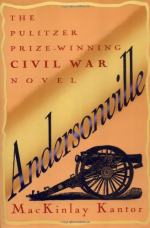We found this a small copy of Andersonville. There was a stream running north and south, on either side of which was a swamp. A Stockade of rough logs, with the bark still on, inclosed several acres. The front of the prison was toward the West. A piece of artillery stood before the gate, and a platform at each corner bore a gun, elevated high enough to rake the whole inside of the prison. A man stood behind each of these guns continually, so as to open with them at any moment. The earth was thrown up against the outside of the palisades in a high embankment, along the top of which the guards on duty walked, it being high enough to elevate their head, shoulders and breasts above the tops of the logs. Inside the inevitable dead-line was traced by running a furrow around the prison-twenty feet from the Stockade—with a plow. In one respect it was an improvement on Andersonville: regular streets were laid off, so that motion about the camp was possible, and cleanliness was promoted. Also, the crowd inside was not so dense as at Camp Sumter.
The prisoners were divided into hundreds and thousands, with Sergeants at the heads of the divisions. A very good police force-organized and officered by the prisoners—maintained order and prevented crime. Thefts and other offenses were punished, as at Andersonville, by the Chief of Police sentencing the offenders to be spanked or tied up.
We found very many of our Andersonville acquaintances inside, and for several days comparisons of experience were in order. They had left Andersonville a few days after us, but were taken to Charleston instead of Savannah. The same story of exchange was dinned into their ears until they arrived at Charleston, when the truth was told them, that no exchange was contemplated, and that they had been deceived for the purpose of getting them safely out of reach of Sherman.
Still they were treated well in Charleston—better than they bad been anywhere else. Intelligent physicians had visited the sick, prescribed for them, furnished them with proper medicines, and admitted the worst cases to the hospital, where they were given something of the care that one would expect in such an institution. Wheat bread, molasses and rice were issued to them, and also a few spoonfuls of vinegar, daily, which were very grateful to them in their scorbutic condition. The citizens sent in clothing, food and vegetables. The Sisters of Charity were indefatigable in ministering to the sick and dying. Altogether, their recollections of the place were quite pleasant.
Despite the disagreeable prominence which the City had in the Secession movement, there was a very strong Union element there, and many men found opportunity to do favors to the prisoners and reveal to them how much they abhorred Secession.
After they had been in Charleston a fortnight or more, the yellow fever broke out in the City, and soon extended its ravages to the prisoners, quite a number dying from it.




